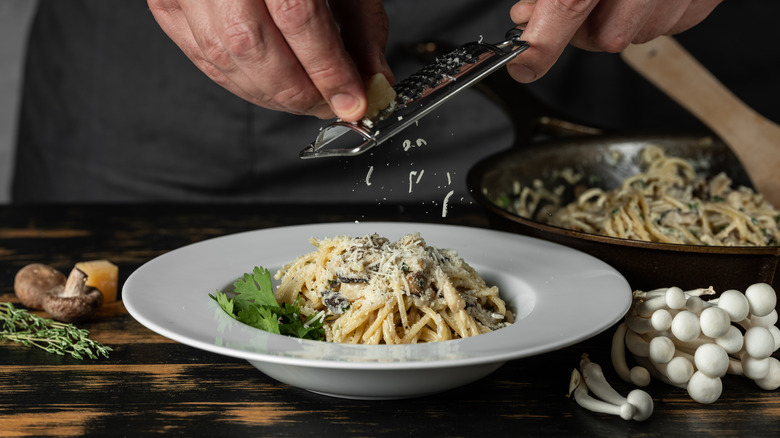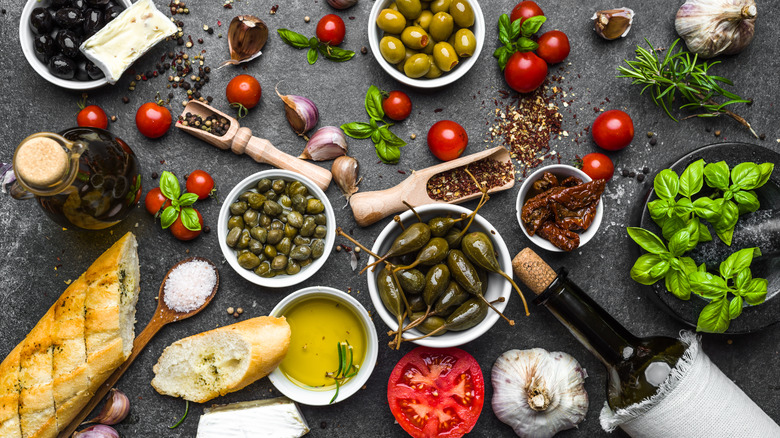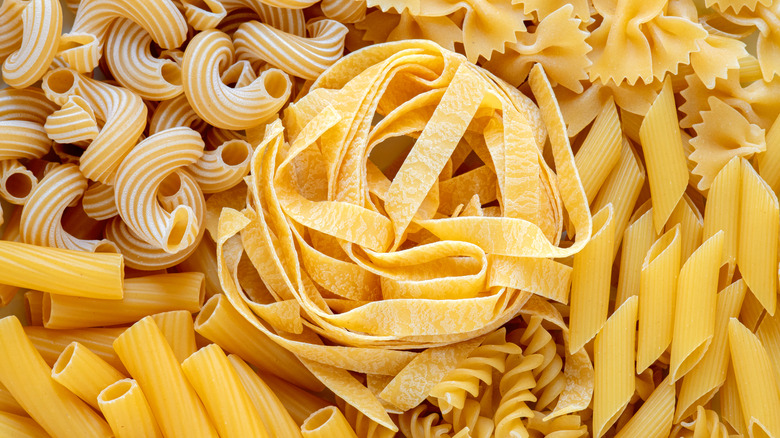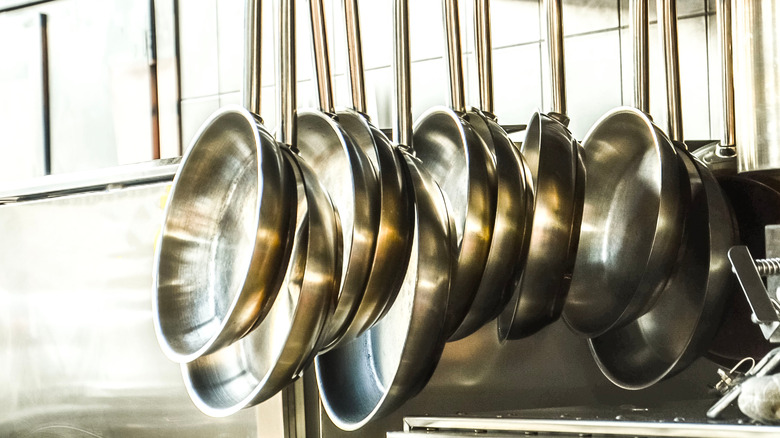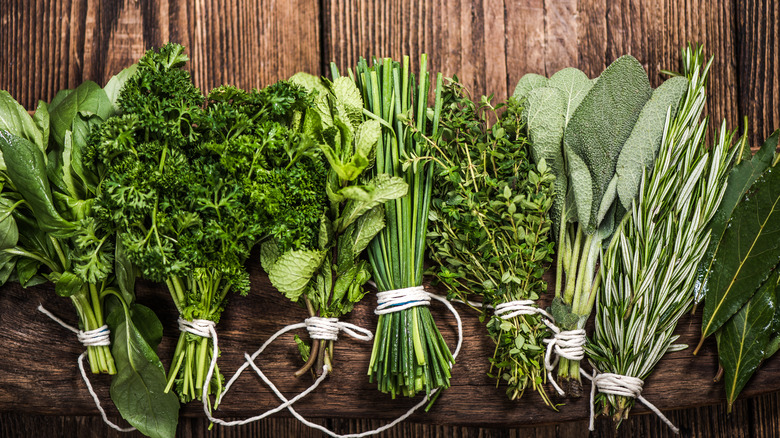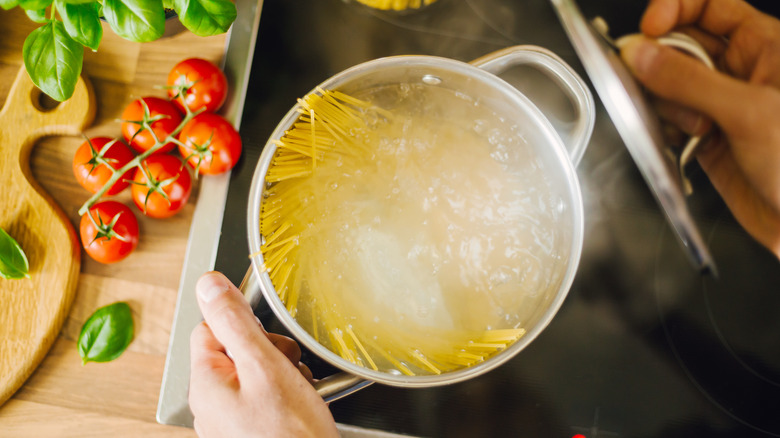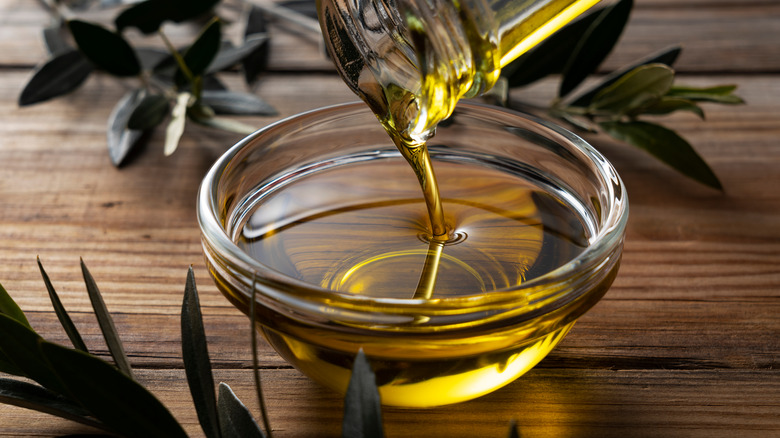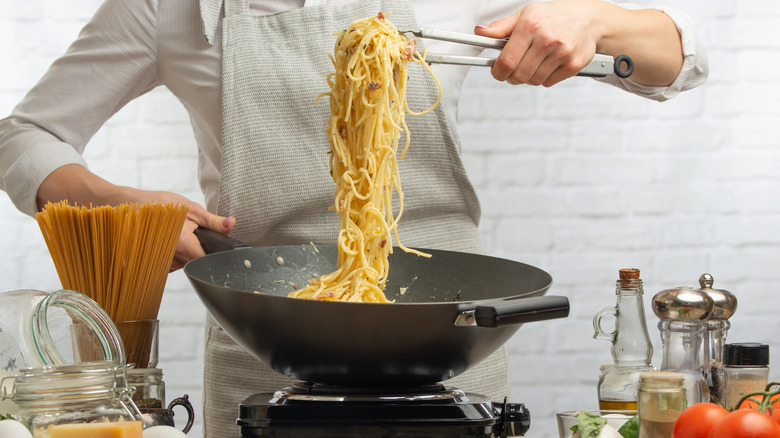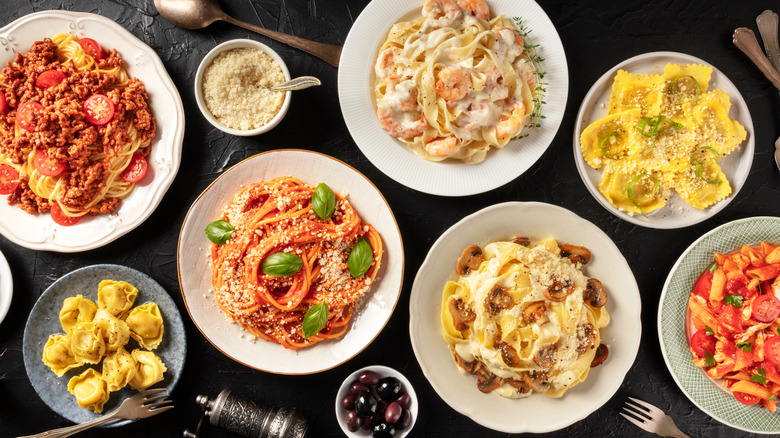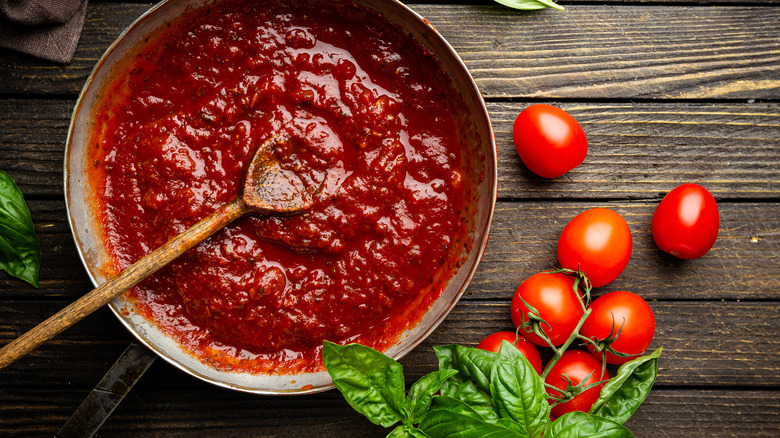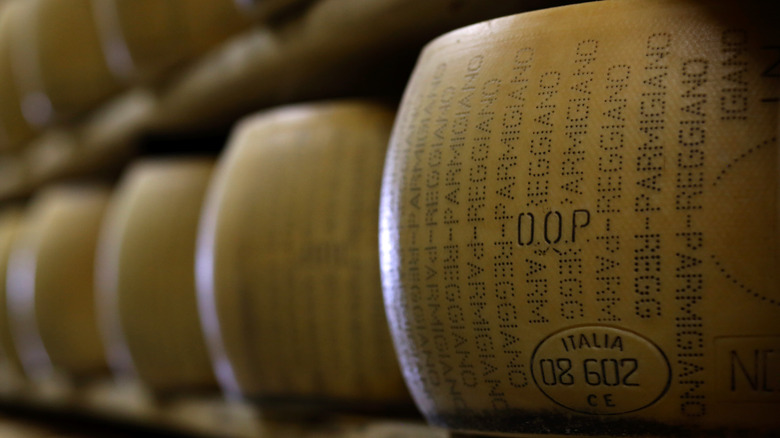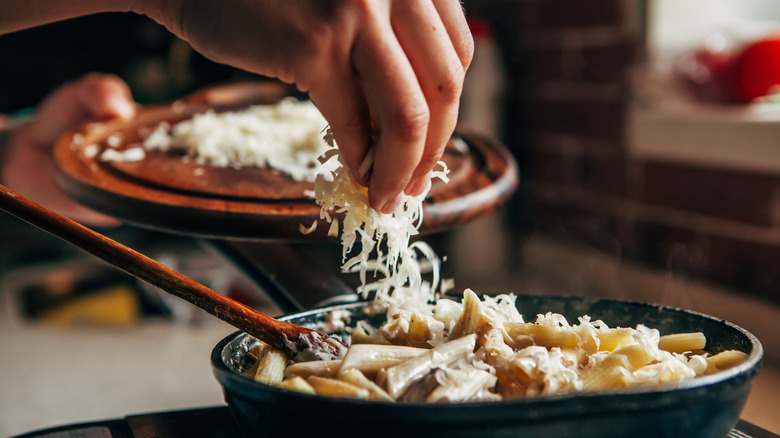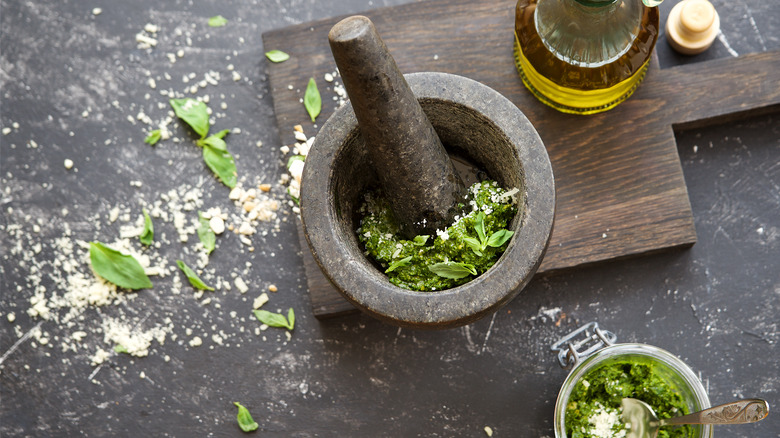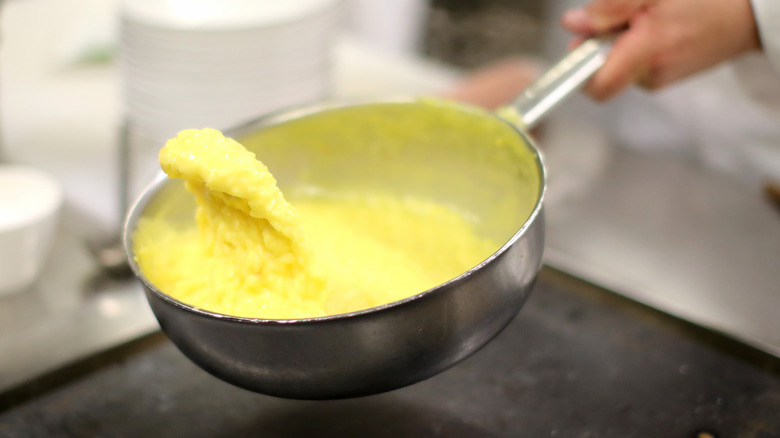Italian Restaurant Secrets You Can Use At Home
Is it the oversized grinder that spits its fine, peppery powder all over your risotto? Maybe it's the excitement of seeing so many steaming plates of pasta in one room. Or perhaps it's the feeling that you are entering a sacred space, the likes of which have been immortalized in movies such as "The Godfather" and Stanley Tucci's 1996 classic, "Big Night." Whatever it is, we can all definitely agree that Italian restaurants are a very special place.
In fact, there is something uniquely gratifying about Italian food in general — a satiation that can be hard to find in some other cuisines. This, along with its wholesome flavors and ingredients, has helped make Italian cuisine the world's favorite, as reported by YouGov. Yet so often, when we try our hand at making our own versions of Italian favorites, they come up lacking. The dish is usually missing that little something extra the Italians call "brio," meaning vigor or vivacity — and you know it when you taste it. So, what is it that sets the plate of pasta you get at your local Italian restaurant apart from the one you make at home? More than likely, it's not just one trick, but many small trade secrets that, when combined, can cause any Italian dish to sing with gusto comparable to that of the late, great Luciano Pavarotti.
Only use the best, freshest ingredients
Italian cooking is known for simple recipes that pack an impressive amount of flavor. Think spaghetti alla puttanesca, caprese salad, or even the humble pizza margherita. As all these delightful dishes demonstrate, Italian chefs rely on the flavor and freshness of their ingredients to carry the recipe, instead of always turning to the spice cupboard (per The Italian Kitchen). And this reliance on fresh produce should come as little surprise. After all, Italian cuisine did originate in the fertile lands and amicable growing conditions of the Mediterranean.
You may be lucky enough to be living in one of the five Mediterranean climate regions around the world (Californians, we're looking at you). But if you can't stroll into your backyard and pick a perfectly ripe, homegrown tomato, does that mean your Bolognese is not worth making? Not exactly. Great produce can be sourced in cities across the globe, as evidenced by the great Italian restaurants you can find all around the world. However, not all produce is good produce, and it will pay dividends to put effort into sourcing the best available fruits and vegetables in your area. One sure-fire way of maximizing the flavor of your ingredients is to buy organic. As reported by National Geographic, the higher levels of antioxidants present in organically grown produce bring out more intense flavors and aromas during the cooking process, which can only benefit your final dish.
Match your pasta type with the correct sauce
From penne to pappardelle, fusilli to festoni, there seems to be a pasta type for every imaginable occasion. And with over 600 recorded pasta shapes, according to the National Pasta Association, it is understandable that many of us feel overwhelmed when trying to decide which one to use. However, remaining pasta illiterate is not an option if you desire your dish to match that of professional kitchens.
Generally speaking, the pasta shape used is determined by the sauce it will be served with. The role of the former is to act as a perfect vessel for the latter; the pasta should remain coated in sauce as it travels from plate to mouth. As BBC Good Food comprehensively explains, each type of pasta is expected to be served with a corresponding type of sauce. For example, long thin pastas, like spaghetti and linguine, should be served with lighter, creamy sauces. On the other hand, rich and meaty sauces pair well with wider, long pastas, such as tagliatelle, in order to maximize sauce pickup (per Pasta Evangelists). Of course, this means that the beloved spaghetti Bolognese is a categorically incorrect and inauthentic pasta preparation. Do with that information what you will.
Invest in good cookware
You've probably heard the saying, "a bad workman blames his tools." Well, we can all rest assured that said workman never worked the line at an Italian restaurant. In that kind of environment, the correct equipment is absolutely key to producing top quality Italian food. And the same is true in your home kitchen. As reported by Daniel Gritzer at Serious Eats, the right equipment is essential for proper pasta-making. More specifically, Gritzer says perfectly sized pans are crucial for the correct execution of techniques like "la mantecatura" — the finishing step in which noodles, sauce, pasta water, and fat are emulsified to silky perfection — without which cacio e pepe, and other pasta dishes like it, simply would not be the same.
However, there is nothing worse than a kitchen drawer stuffed full of niche, barely touched equipment. You do not need 20 different knives and a plethora of pots to make a good meal. The perfect middle ground is to have a small number of well-crafted, versatile tools that cover most bases. Rachel Roddy, The Guardian's pasta guru and a resident of Italy's capital, would agree. Her standouts include a small chestnut knife, used for things like preparing vegetables and scraping mussels, and a food mill, an Italian kitchen staple used to create sauces with that ideal, distinctively lumpy texture.
Know your herbs
Herbs are an integral part of Italian cuisine. However, our understanding of them is often somewhat lacking. This knowledge gap is created in part by the prominence of Italian herb seasoning, which does a wonderful job of making all your different dishes taste exactly the same. When looking to transition away from this generic premix and use distinctive herbs to season your dishes, the first thing to understand is when to use dried and when to use fresh. Italian cooks generally prefer dried thyme, bay leaf, and even oregano; when it comes to leafier herbs, like basil and parsley, fresh is always best (via Martha Stewart).
Another frequent slip-up made by home cooks is adding herbs at the wrong time. A prominent example of this is adding fresh basil to a pizza before it enters the oven. The best time to add fresh herbs to pizza — and almost anything else for that matter — is in the last few minutes of cooking, right before serving, or as a garnish in the very last stage of plating (via Chatelaine). On the other hand, dry herbs need more time to release their flavor, so they should be added to dishes much earlier in the cooking process. And just in case it bears repeating, only add your basil once the pizza is out of the oven.
Don't throw away your pasta water
Despite no longer being the industry secret it once was, retaining your pasta water still remains a practice of utmost importance. This cloudy liquid that's leftover after boiling your noodles quite literally becomes the emulsifying glue that holds your pasta sauce together. It's a staple practice that Italian restaurants have been perfecting for decades — one that's become well-known among food bloggers and home cooks.
But the best restaurant chefs do have another trick that may be more of a secret: adding fat. When tossing pasta water into your pan to make sauce, the addition of butter, oil, or even cheese can work wonders — simultaneously allowing thin sauces to emulsify further, and preventing thicker, overly starched sauces from completely coagulating (via Serious Eats). Beware, however, of recipes that call for adding fat (in the form of olive oil, usually) to pasta while it is boiling. While it's been said that this can help prevent the noodles from sticking together (we're not convinced), it will also have the sad effect of preventing your delicious sauce from gripping the pasta (per Eataly).
Use the correct type of olive oil
Olive oil, the golden blood that courses through the veins of Italian cuisine, is a product that is simultaneously highly prized and commonly misunderstood. As explained by Healthifyme, there are five main types of olive oil: extra virgin olive oil, virgin olive oil, pure olive oil, refined olive oil, and olive pomace oil. Confusing, right? To simplify matters, copy the professionals and ensure that your first port of call when making a dish is extra virgin olive oil (via Epicurious). While it's not suitable for all types of cooking, you can generally rest assured that it's rich, fruity, and slightly bitter flavors will benefit the majority of dishes (per Great Italian Chefs).
However, you should avoid using extra virgin olive oil to cook food at very high temperatures. The oil has a low smoke point and will quickly start to burn, potentially losing both its flavor and health properties (per Healthline). When performing high-temperature tasks, it's better to use a lower grade of olive oil, like virgin olive oil or refined olive oil (via Masterclass).
And if you're deep frying, consider using olive pomace oil. It's extracted from the leftover by-products of regular olive oil production (via Livestrong). In order to be suitable for consumption, olive pomace oil must undergo a number of chemical processes to refine it. This results in an oil with an extremely high smoke point that imparts no taste on the food it is cooked with (via Centra Foods).
Always finish cooking your pasta in the sauce
There are many mistakes you can make when getting to grips with Italian cuisine, and pasta provides more than its fair share of pitfalls. Most glaring among these, and perhaps of all Italian food faux pas, is to serve a bowl of naked pasta with sauce heaped on top of it. This is simply not the way it is done. As travel industry entrepreneur, Jason Spiehler (who happens to be married to an Italian), explained to The Guardian, "pasta and its sauce should be combined like salad and its dressing. The sauce should never be overabundant in order to allow the pasta and its grain to also be tasted as the standalone delicacies that they are."
The way this is achieved is through "la mantecatura," the hallowed technique wherein pasta is added to a pan of sauce, along with a splash of pasta water and some kind of fat, and then stirred vigorously until it forms a creamy blend (per My Pinch of Italy). This crucial finishing step not only emulsifies the sauce, but also ensures that each piece of pasta is thoroughly coated. A dish finished in this manner, regardless of what type of sauce is used, will develop a delightfully rich mouthfeel as the sauce grips the pasta. But bear in mind that this final step requires very high heat, so be prepared to stir vigorously to avoid any sticking (via Serious Eats).
Don't overcrowd your dishes
Contrary to the topping-heavy Italian dishes that are seen stateside, true Italian cuisine is all about simplicity. This should not be startling news for Americans — cookbook author and Italian food expert, Nancy Harmon Jenkins, wrote an article for The New York Times in 1997 alerting the country to this very fact. Jenkins says Americans tend to forget pasta dishes should be about pasta and nothing else. Crimes such as adding meat to pasta dishes or overloading the final product with cheese do little to uphold the traditions of Italian cuisine.
Adding a bunch of flavors that fight for our palate's attention is an easy mistake for home cooks to make. The impulsive need to add garlic to anything that resembles an Italian dish is a prime example, one that brings cries of lament from Italian natives (via The Guardian). Kathleen Zelman, a nutritionist who has written for The Wall Street Journal and The New York Times, even suggests that the unnecessary inclusion of certain herbs can overpower your star players in lighter dishes. Truly brilliant Italian restaurants understand that moderation is the key to success. However, for those of us hellbent on impressing our dinner guests, staying our eager hands can prove more difficult. If that sounds like you, it might be beneficial to take CNN Travel's advice, and start your Italian culinary education by practicing some of Italy's simple, classic dishes, such as the bare bones caprese salad.
Be patient with your sauces
Sauces — be they ruby red tomato ones, bright green pestos, or creamy white besciamellas — form an integral part of Italian cuisine. A complex, rich sauce can make a dish, especially in a cuisine as pared back as Italian, where recipes like pasta al pomodoro often steal the limelight. This classic red sauce is an Italian staple, and while there are a range of methods and techniques to perfect it, everyone can agree that it should be cooked low and slow (via Foodie Crush). The lengthy simmer allows all those bright tomatoes to release their acidic juices, which need time to evaporate, lest they ruin the careful balance of your dish (via The Guardian). For richer, heavier tomato sauces, suited more to meat-based dishes, Serious Eats has taken the low and slow approach to a whole new level. Their oven-baked tomato sauce calls for a whopping 6 hours of cooking time, but the complex, sweet, and addictive sauce that results is said to be totally worth the wait.
Fortunately, not all of Italy's delectable sauces require vast amounts of time to prepare. Pesto alla Genovese is deceptively quick to make, even when using a traditional mortar and pestle to grind the ingredients together (via Delicious). However, the best chefs know that a little more effort can improve even this easy recipe — simply toasting the pine nuts adds a deep nuttiness to this already nuanced sauce (per Bon Appétit).
Keep your cheese rinds
Parmigiano Reggiano is dubbed the king of cheese for a reason: Its complex flavor and crystalline texture forms the basis, and topping, for many of Italy's favorite dishes. As such, any budding chef will rattle their way through this hard cheese at an impressive rate, especially if churning out Italian American classics such as chicken parmigiana (via The New York Times).
Coming to the end of a block of cheese signals nothing more to most than the fact that it is time to go buy some more. But for those in the know, the sight of that lonesome rind is enough to make your heart sing. That's because there are a multitude of uses the rind can be put to that will elevate humble home-cooking to the level of a professional kitchen. Primarily, the rind can be thrown into any sauce to impart its unique flavor — just bear in mind that this process will add a surprising amount of saltiness to your sauce (per Eataly). You can also use leftover cheese rinds to make homemade broth. As Tasting Table explains, this can be used in place of stock when making risotto, resulting in a dish that is sure to be unparalleled in its flavor and creaminess.
Do not overuse parmesan
While wonderful, parmesan cheese is a product that can very quickly come to overpower a dish, dominating the flavor profile and ensuring you can taste little else (via The Local). Italian restaurants, well-versed in this knowledge, will not heap piles of parmesan on top of seafood pastas or dishes with delicately flavored ingredients (per The Independent). However, these establishments are there to serve, and as those who have worked in the service industry know, the customer is always right (even if they want to overload their dish with cheese). To wriggle their way out of this bind without defacing their beloved recipes, many Italian restaurants will provide customers with a bowl of cheese for them to sprinkle as they see fit.
Some take requests for parmesan a little bit worse than others. As reported by Metro, a restaurant in London outright refused to add parmesan to one customer's crab ravioli. The ensuing drama, which included a one-star review and a fiery reply from the owner, went viral on Twitter, eliciting a range of strong opinions. And while it's not advisable to take such a hard-line approach in your own Italian cooking, it is wise to remember the incredible potency of grated parmesan cheese and the emotions it can elicit.
Use a mortar and pestle
You might think that professional kitchens are all about high-tech methods and equipment, and with good reason too; the sous-vide craze of the early 2000s still haunts our minds. Yet, for Italian kitchens, old school is most frequently the best school. This is no more apparent than through the continued use of the mortar and pestle, a 10,000-year-old kitchen tool which has never gone out of fashion (via The Atlantic).
The most famous use of the mortar and pestle in Italian cooking is to make pesto. As internationally acclaimed chef, Samin Nosrat, wrote for The New York Times, pesto made in the traditional manner emulsifies in a unique way, producing a sauce that is unmatched in its creaminess and flavor. Food & Wine suggests the superior taste of pesto, and other items prepared with a mortar and pestle, is due to the grinding motion, which releases the ingredient's flavorsome and aromatic essential oils. Simply put, a mortar and pestle is absolutely essential hardware for all cooks looking to take their Italian food to the next level.
Acquaint yourself with polenta
La cucina povera — a traditional method of Italian cooking that focuses on simple recipes made with limited ingredients – has formed the backbone of Italian cuisine's rise to global fame (via Franco London). Dishes and ingredients inspired by this method, like bruschetta, ribollita, even proscuitto, have come to prominence and can now be found in Italian restaurants across the world (via Eataly). However, one integral dish of la cucina povera, which has received less attention from both professional chefs and home cooks alike, is polenta.
Polenta, made from cooked cornmeal, is an extremely popular comfort food in Northern Italy and can be served with a number of toppings (per La Cucina Italiana). But polenta is not only served as a main dish in Italian cooking; it can also be used as an ingredient in other recipes. When dried, polenta is used to make popular desserts, such as brustengolo, a traditional Umbrian fruitcake (via Madonna del Piatto). Polenta's versatility and warm, comforting nature mark it as one to master for any home cook looking to produce a delicious and intriguing alternatives to Italian cuisine's stalwarts of risotto, pasta, and pizza.
